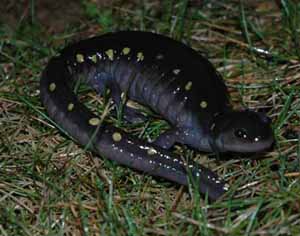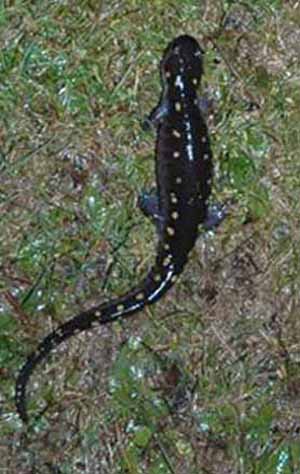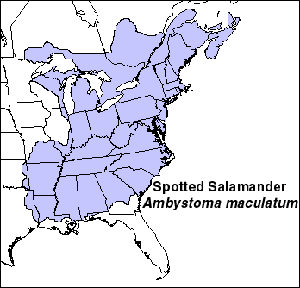Spotted Salamander - Ambystoma maculatum
The Spotted Salamander is one of the larger members of the mole salamander family reaching lengths of nearly 8 inches or more. The dorsal background color is black, dark brown or dark gray with a slate gray belly. Young individuals sometimes have a dark brown background color. The background color is broken up by the presence of yellow spots arranged in two irregular rows running along the sides from the head to the tail. The first pair of spots (from the head) are usually orange. They are most likely to be confused with the Eastern Tiger Salamander, but the yellow spots on this species are more irregular in both form and placement. There may be laws the prohibit keeping these animals. Check local and state laws.
Average Size - Average size of an adult is 5-7 inches long, with some over 9 inches long
Life Span - Spotted salamanders may live more than 20 years
Diet - Spotted salamanders eat invertebrates such as earthworms and insects or anything else they can catch and swallow. So what other small frogs, newts etc would eat is what the spotted salamander would eat.
Feeding - Spotted salamanders do not have to be fed every day - every other day or every three days is often enough. It may take a little experimentation to figure out how much and how often they should be fed, but you can try to judge by their growth and body condition (fat or skinny) and whether excess food is being left (which will cause toxins to build up in the tank).
Housing - A 20 gallon tank will hold maybe 2 animals, remember these are fairly large amphibians. Spotted salamanders, like other herps, will gladly wonder off if given the chance, so your cage will need a secure top.
Substrate - Loosely packed soil with partially buried "logs" and rocks to help break up the soil and allow the spotted salamander to burrow will work.
Habitat - Spotted salamanders are common in bottomland forests near floodplains, but also occur in upland  forests and in mountainous regions. Like other closely related species of mole salamanders, spotted salamanders spend most of their lives on land and migrate to ponds for breeding. Nearly all of their time is spent underground in burrows of other animals. Occasionally, they are found above ground on damp or humid nights. The only time they are found above ground in numbers are during heavy spring and fall rains while they migrate to and from overwintering sites. forests and in mountainous regions. Like other closely related species of mole salamanders, spotted salamanders spend most of their lives on land and migrate to ponds for breeding. Nearly all of their time is spent underground in burrows of other animals. Occasionally, they are found above ground on damp or humid nights. The only time they are found above ground in numbers are during heavy spring and fall rains while they migrate to and from overwintering sites.
Temperature - Perhaps the most convenient part of spotted salamander as with red spotted newt keeping is the fact that virtually all species can be kept at room temperature or even cooler. No special heating is required. The ideal temperature for newts is about 60 – 65 degrees F. In the spring when the breeding season rolls around, you will have to raise the temperature a bit, which can be done naturally if you live in an area where the seasons are well defined. If you wish to hibernate keep them at about 40 degrees Fahrenheit for a few weeks and them warm them up slowly when you re ready to bring them back out – this can also help facilitate breeding.
Lighting - Because of their life style - burrowing - spotted salamanders do not need of full spectrum lighting, regular lighting is appropriate.
Humidity - Keep a somewhat humid environment. Humidity levels of 60 – 70% are fine. Misting several times a day and fully soaking plants and substrate should provide enough humidity. Watch for fungus, molds, etc. – these should not be allowed to stay.
Water - Without moisture, Spotted Salamanders will dry out and die. A small bowl can be kept - but the tank should be misted daily to keep the substrate moist. As stated above, do no let the cage bottom develop puddles on the bottom as fungus and bacteria can become established which can be harmful to the salamander.
Normal Behavior and Interaction - Spotted salamanders are fairly solitary animals. Interaction is mostly during breeding season. The adults migrate to the breeding ponds during periods of heavy snowmelt, warm spring rains, or humid nights if there is no rain. The two pictures here were taken during a spring migration in Binghamton, New York. There were over one-hundred spotted salamanders attempting to cross a road - they were protected by a group of SUNY - Binghamton students that kept them from being run over by cars. It is thought this is not uncommon and that migrations appear to be synchronized.
Males court the females by nudging and rubbing them with their snouts. The male drops a spermatophore,  which the female walks over and picks up with her cloacal lips. Males may drop nearly 100 spermatophores in a season. The breeding period lasts from a couple nights to over a week. The time varies by location. The females then lay from 1 to 200 eggs in a globular mass. The mass is attached to twigs or other underwater structures; very rarely they are laid on the bottom. The mass is covered with a jelly-like coating which may be clear or white. The eggs hatch in only a few weeks. The larvae actively feed and grow for 2 to 4 months. The larval stage varies based on geographic location and water temperature. which the female walks over and picks up with her cloacal lips. Males may drop nearly 100 spermatophores in a season. The breeding period lasts from a couple nights to over a week. The time varies by location. The females then lay from 1 to 200 eggs in a globular mass. The mass is attached to twigs or other underwater structures; very rarely they are laid on the bottom. The mass is covered with a jelly-like coating which may be clear or white. The eggs hatch in only a few weeks. The larvae actively feed and grow for 2 to 4 months. The larval stage varies based on geographic location and water temperature.
Larvae will transform into adults in two to four months. Until that time they will continue living in water, eating insect larvae, water fleas, and other small creatures. If there isn't enough food, they will even eat each other.
When they leave the water as adults, the young salamanders are about two and a half inches long. They survive best in ponds that do not contain fish, which will eat larvae.
It has been written that acid rain has greatly diminished this species. The ponds have become too acid for eggs to develop thus causing whole areas to die out.
Recommended Supplies
- Habitat with secure lid
- Thermometer
- Light timer
- Misting bottle
|
- Substrate - should be deep enough and loose enough for the salamander to burrow into
- Driftwood and rocks
- Incandescent light or ceramic heater
| Habitat Maintenance Change water daily. Thoroughly clean the tank at least once week: set newt aside in a secure habitat; scrub the tank and furnishings with a 3% bleach solution; rinse thoroughly with water, removing all smell of bleach; dry the tank and furnishings; and add clean substrate
Grooming and Hygiene When cleaning housing, check salamander for any abrasions, signs of parasites or or fungal infections. Always wash your hands before and after touching your newt or habitat contents to help prevent Salmonella and other infectious diseases. Adults secrete a milky toxin from glands on the back and tail for defense against predation
Signs of a Healthy Pet:
- Clear eyes
- Clear nose and mouth
- Active and alert
|
- Eats regularly
- Healthy skin
|
Common Health Issues and Red Flags:
- Vomiting
- Discharge in nose or mouth
- Lethargy
|
- Abnormal feces
- Decreased appetite
- Cloudy eyes
|
If you notice any of these signs, please contact your exotic animal veterinarian.
As with all pets in this category, it is important that you find a veterinarian that practices in EXOTICS – this is critical. The typical small animal practitioner may not have sufficient knowledge in this area.
Even this guide is general in nature and should not be used to diagnose your pet.
|



 forests and in mountainous regions. Like other closely related species of mole salamanders, spotted salamanders spend most of their lives on land and migrate to ponds for breeding. Nearly all of their time is spent underground in burrows of other animals. Occasionally, they are found above ground on damp or humid nights. The only time they are found above ground in numbers are during heavy spring and fall rains while they migrate to and from overwintering sites.
forests and in mountainous regions. Like other closely related species of mole salamanders, spotted salamanders spend most of their lives on land and migrate to ponds for breeding. Nearly all of their time is spent underground in burrows of other animals. Occasionally, they are found above ground on damp or humid nights. The only time they are found above ground in numbers are during heavy spring and fall rains while they migrate to and from overwintering sites. which the female walks over and picks up with her cloacal lips. Males may drop nearly 100 spermatophores in a season. The breeding period lasts from a couple nights to over a week. The time varies by location. The females then lay from 1 to 200 eggs in a globular mass. The mass is attached to twigs or other underwater structures; very rarely they are laid on the bottom. The mass is covered with a jelly-like coating which may be clear or white. The eggs hatch in only a few weeks. The larvae actively feed and grow for 2 to 4 months. The larval stage varies based on geographic location and water temperature.
which the female walks over and picks up with her cloacal lips. Males may drop nearly 100 spermatophores in a season. The breeding period lasts from a couple nights to over a week. The time varies by location. The females then lay from 1 to 200 eggs in a globular mass. The mass is attached to twigs or other underwater structures; very rarely they are laid on the bottom. The mass is covered with a jelly-like coating which may be clear or white. The eggs hatch in only a few weeks. The larvae actively feed and grow for 2 to 4 months. The larval stage varies based on geographic location and water temperature.